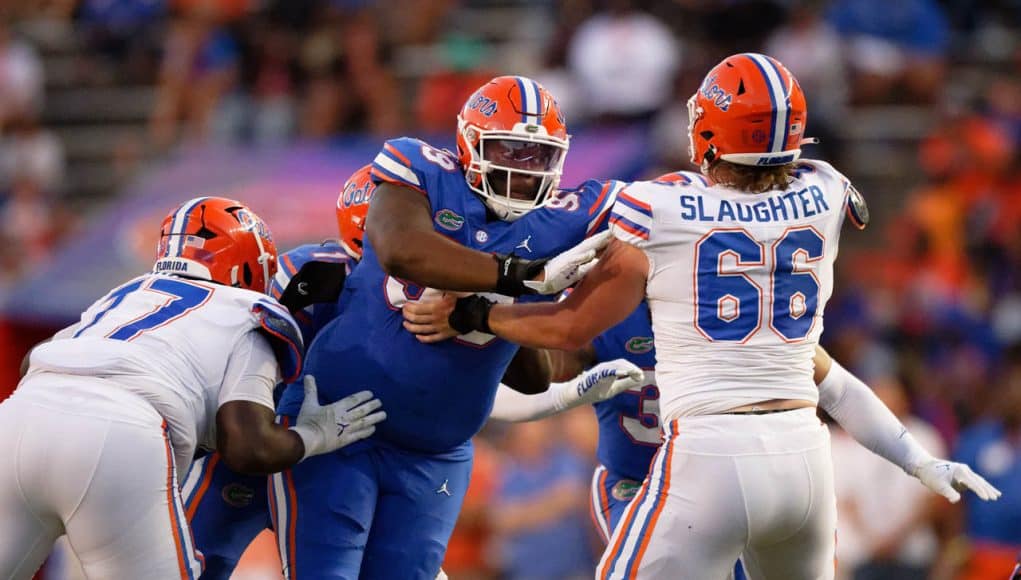If you see a new coach have a depth problem, it’s probably traceable to recruiting missteps by the previous regime. Especially so if, as was the case for Billy Napier, there was not an immediate transfer portal exodus upon the new guy’s arrival.
It’s no secret that Florida lacked depth at defensive tackle last year. The weekly depth chart went three deep at both interior spots — nose guard, and then the nominal second “defensive end” spot in a 3-4 alignment that is basically a defensive tackle, which I will refer to as such — but by season’s end the team mainly leaned on just three players.
Gervon Dexter played way too many snaps at the DT spot, at nearly 700 on the year. Desmond Watson took over the starting spot at nose during the season, and he logged a bit over 400 snaps of his own. For a gentleman that large, it’s a massive number. And then by the end of the season, true freshman Chris McClellan was a regular presence in the middle as well.
There were some other veterans in the mix. Jalen Lee was the starter at nose to begin the season, but he fell down the chart as Watson and McClellan rose. He’s since transferred to LSU. Jaelin Humphries was a regular presence on the third line in the weekly releases, but he only appeared in four games. Injuries derailed his career early on, and he’s yet to get back on track.
The lack of production from the veterans outside Dexter and Watson meant redshirt freshman Tyreak Sapp was able to get significant run. He finished with more assisted tackles (12) than Lee and Humphries combined (ten). Tackle stats aren’t everything for interior linemen, as the stat-less activity of eating blocks is often the assignment, but you want to see a guy put ball carriers on the ground when possible. And when you have a pair of freshmen playing a lot of snaps in the middle of your SEC defensive line, you know it’s going to be a tough year. Nothing against McClellan and Sapp, who are promising young players, but you really want more older guys who’ve had years to develop their physiques.
We got to that place because of Dan Mullen’s recruiting. In 2018, he signed only one interior defensive lineman in Malik Langham. He played sparingly for a year and hit the portal after 2019 spring practice. The ’19 class netted only Humphries, and again, he battled injury for years to start his career. In 2020 the staff seemed to realize the problem and signed three in Dexter, Lee, and Lamar Goods, but the latter never panned out at UF and eventually ended up back home in Canada.
So in Mullen’s first three recruiting classes, he ended up with only two defensive tackles who appreciably contributed. One was a star in Dexter, but the other was just a rotation guy. That math doesn’t work out for sustaining success, which is why Mullen scrambled to add three graduate transfers at the position in 2021.
That was the mess at defensive tackle that Napier walked into last year. He managed to keep McClellan in the fold for 2022, but he didn’t add any transfers. It showed.
The 2023 season will be much different, and not just because Dexter is now a Chicago Bear.
A couple of transfers, Cam Jackson from Memphis and Caleb Banks from Louisville, are top candidates to start. Getting real quality and not just some warm bodies at DT from the portal is hard to do, but Napier appears to have done it twice. He’s already started talking them up as a top pairing in the middle of the defensive line.
That instant shot of depth means that Watson won’t have to play near as many snaps and should stay fresher for longer. It’s important for all big dudes to stay fresh, but it really is for him especially.
It also means that Watson and McClellan, two of last year’s top players, are the first ones off the bench. The second line on the chart will have two reliable performers, something it didn’t have a lot of last season. It’s possible that McClellan could get the starting nod over Banks, but I expect to see a lot of rotation among the top four guys and all possible combinations at some point.
And then, the third line will probably consist ’22 signee Jamari Lyons and ’23 signee Will Norman with Sapp having moved outside in the wake of Justus Boone’s season-ending injury. That’s where you want to see the younger guys instead of them being thrown into the fire right away. Lyons is more likely to see regular snaps than Norman is under normal circumstances.
You can’t overstate the importance of quality in the middle of the line. It’s the thing that makes the rest of a defense work, and it makes everyone else’s job easier.
A team can press with corners and take chances in pass defense more often if the quarterback is hurried (or worse) a higher percentage of the time. Linebackers see less clutter when the nose is occupying two offensive linemen. It won’t matter if a relatively green safety crashing the box in run support fills the wrong hole if the defensive tackle is blowing up the mesh point on a read option.
Florida has struggled to get stops to close out games in each of the last three seasons. The defensive tackles being out of gas is a prime reason for it.
Not only should UF be stronger down the stretch with more depth in its interior line, but every defender’s job will be easier through out the game. If you’re looking for a defensive renaissance in Gainesville after a couple of painful seasons, look no further than nose and defensive tackle as the root of the change.


